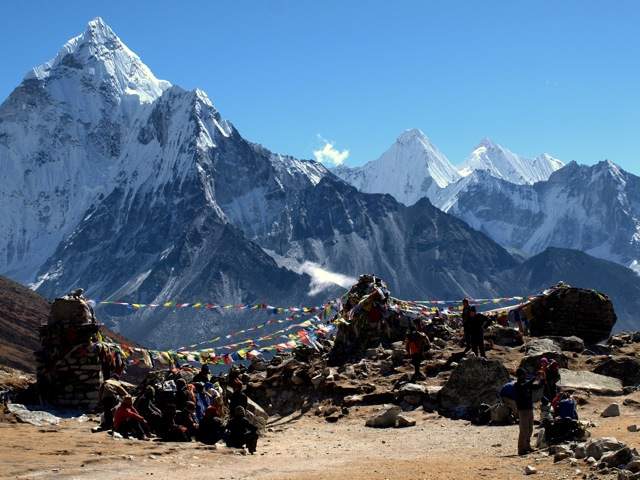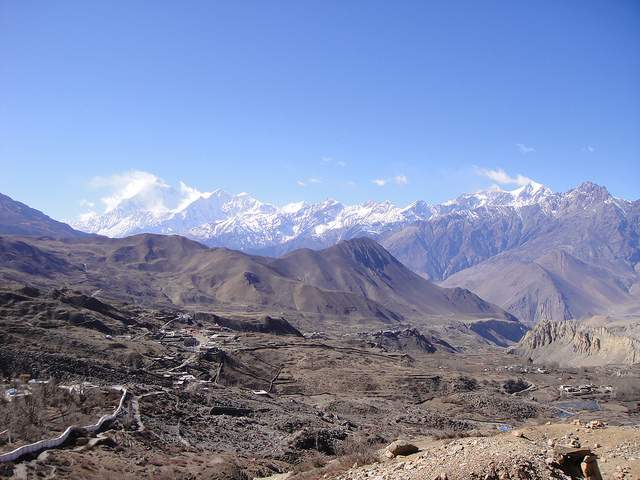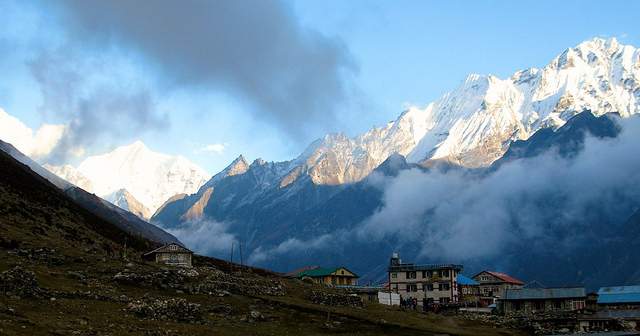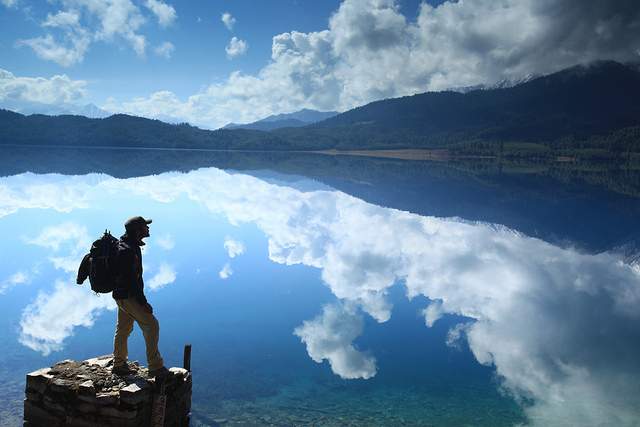Nepal is, hands down, the best trekking destination on earth. For starters, it’s cheap compared to most other countries, making epic week(s)-long excursions to such places as Everest Base Camp or the Annapurna Sanctuary possible for budget travelers. Second, it has the world’s highest mountains, with fully one-third of the great snow-capped Himalaya contained within its borders. And finally, any trek you do in Nepal will give you the opportunity to experience the unique cultures of Nepal’s highlands.
From the forbidden kingdom of Mustang to the soaring peaks around Dhaulagiri, Annapurna and Mount Everest, the opportunities for trekking in Nepal are many. Here is a look at some of the most exciting trekking opportunities in the country, with information on how to prepare and what you’ll need to pack.
Adding Nepal to your multi-stop trip
If you’re big on trekking and have dreamed of planning a long trip around it, then this is the itinerary for you.
This 4.5 month RTW trip spends summer in the Western United States, from Colorado to Utah to Arizona to California, before heading to New Zealand, northern Vietnam, and Kathmandu – a trekker’s dream trip!
To customize this trip, register for a free BootsnAll Membership, and you’ll be able to utilize all of Indie’s capabilities to plan your next big getaway.
Best time to go:

- October-November: Nepal’s peak trekking season, with mild weather, clear skies, and big crowds.
- November-December/January-February: clear skies, but potentially very cold. Trekkers should bring snow gear and be prepared to turn back due to blocked paths.
- February-April: end of the dry season and the second-best time to go trekking. Visibility in the mountains can be hazy due to dust, but the trails are free from snow.
How to prepare, what you’ll need to bring
What you need to bring on your trek is depends on which trek you’ll be doing and what time of year you’ll be doing it. The treks listed below are non-technical and can be accomplished by most everyone in decent shape (as long as they pace themselves). Thus climbing gear is not required.
One big mistake newbie trekkers make in Nepal is taking their trek too seriously. You’re probably not going to need camping gear, summit body suits, or crampons if you’re doing a mild trek in the middle of September. If you plan to camp, this will change. Likewise if you plan to climb the peak of any mountain along your trek.
The treks listed below are non-technical and can be accomplished by most everyone in decent shape.
A lot of people book trekking tours overseas, which, more often than not, is a huge mistake. These are outrageously expensive compared to what you can arrange once you are in Nepal, or if you arrange to do your trek independently via online trekking forums.
Packing list and gear
What you’ll need, based on a peak season (Sept-Oct) 18-day trek on the Annapurna Circuit, without a porter
Note: This list is relative and depends on the needs of the trekker and the weather.
- Lightweight long-sleeve trekking shirts (3). These help protect you from the sun.
- Lightweight hiking boots (Make sure you break them in beforehand).
- Sandals/crocs for night-time toilet excursions.
- Lightweight rain jacket.
- Hiking socks (3 thick, 2 thin pairs). You can wash them along the way.
- Windproof gloves.
- Long- sleeve cotton t-shirt. Can be used as a sleep shirt or a a base layer.
- One or two long-leg lightweight trekking pants. Zip-offs are the best. Avoid anything too heavy or completely water proof.
- Windproof jacket/windbreaker.
- Toiletry items: hand-soap, toothbrush, toothpaste, etc. and a dry bag to carry them in.
- 4/5 changes of comfortable underwear.
- Hat. One woolen for cold weather, one brimmed for sun protection.
- Sunglasses with UV protection.
- Packet of washing powder (to wash clothes).
- Medium-sized quick-dry towel.
- Bungee cords for hanging up your clothes to dry or attaching things to your pack
- Head torch with extra batteries.
- Water purification tablets or drops.
- Chapstick.
- One or two one-liter water bottles.
- Duct tape, just in case.
- Watch.
- First Aid Kit, containing paracetamol, bite/burn cream, bandages, antiseptic cream and altitude sickness pills
- Toilet paper.
- Trekking map
- Day Pack to stuff the above into.
- Sleeping bag. You won’t need a heavy one, but bring one because during the peak season they might run out of blankets.
- Trekking poles.
Optional:
- Camera/Camcorder batteries. Don’t forget a socket adapter for your charger.
- Swiss Army knife or equivalent.
- Snacks (the higher the elevation, the more expensive and harder to find these will be).
- Chewing gum.
- Thermal underwear. In the higher elevations these will be useful in the morning or for sleeping in.
- Journal, pen.
- Silk sleeping bag liner (if you don’t like to sleep under unwashed blankets).
Check out our master packing list for long-term travel
Everything on this list can be found in Kathmandu or Pokhara at rock-bottom prices, so if you do not own these things beforehand, it will save you a lot of money if you wait until you arrive in Nepal to buy them.
Note: You’ll be carrying, packing and unpacking these things every day, so it would be beneficial not to overburden yourself with things you do not need and will not use. Generally, most people are comfortable with the following weight:
- Shorter treks: 15-17 lbs (7-8kg)
- Medium treks: 22-26 lbs (10-12kg)
- Longer treks: 33-37 lbs (15-17kg)
Read our recommended gear page
Documents and fees:
All trekkers need to register their trek by acquiring a Trekking Information Management System (TIMS) card. The easiest place to do this is at the Tourist Service Center in Kathmandu, as you’ll be able to buy entrance fees to Nepal’s various national parks in the same building. You can also obtain your TIMS at certain stations along certain treks, but it’s much easier to arrange it before you set out.
For the card, you’ll need a photocopy of your passport and two passport photos. Watch out for agencies who offer to register for you, as they’ll charge a commission. If your trek enters a national park area (such as the Everest region or Langtang), you’ll also need a national park fee. For Annapurna treks you must pay a conservation area fee. All of these can be arranged in Pokhara or Kathmandu.
Find out about visas for long-term travel
Porters:
If you have never trekked before and plan to take a lot of equipment, you should consider hiring a porter to help with your load, some of whom speak English (rare). If you’ve hired a guide, they can help you hire a porter, and you can also hire porters who can also serve as guides.
Generally, porters cost half the price of a guide and are allowed to carry 44-66 lbs (20-30kg). You can arrange porters before you leave Kathmandu/Pokhara (you’ll need to pay for their flight if you’re flying), or you can easily hire them at the starting point of your trek. Most porters do not speak English, so be sure to have a translator affirm what you are expecting from each other, including arrangements regarding food, accommodation, and other charges.
Some of Nepal’s Best Treks:

Everest Base Camp, Sagarmatha National Park
Mount Everest dominates the imagination when most people think of the Himalaya. Nestled in the Khumbu region of central Nepal, home to a number of unique Sherpa and Tibetan Buddhist cultures, the trek to Everest Base Camp (EBC) is today the second most popular trek in Nepal. The trail is spectacular, but tends to be a bit crowded during the high season, especially between Lukla and Namche Bazaar. During this time accommodation fills up fast, so it’s a good idea to have a porter on hand, who you can send ahead to reserve accommodation for you.
Tips and specifics: Treks in the Khumbu typically range from 17 to 25 days, depending on the route.
- Most trekkers fly into Lukla (2680m), acclimatize at Namche Bazar (the biggest village in Sagarmatha National Park), then head up the Imja and Lobuche Khola valleys to the Khumbu Glacier and Gorek Shep, a small outpost that provides unparalleled views of Mt. Everest and is the last accommodation point before EBC.
- The base camp itself is honestly not worth the additional day hike, unless it’s to say you’ve been there, as it offers no significant views and even Everest is hidden by a nearby mountain.
- A better option, or an addition optional if you’ve the time and strength, is the trail from Gorek Shep to the top of Kala Pattar (5.6236m), which offers some of the most breathtaking views in the area.
- By far the prettiest town in the region is Gokyo, which straddles the lip of a glacial blue lake and is surrounded by soaring peaks.
- A detour over Chola Pass to Gokyo Lakes on the way back to Lukla is highly recommended. Just keep in mind to bring plenty of cash, as the higher you get the more expensive things become.
Annapurna Circuit

The entire Annapurna Circuit takes nearly three weeks and begins in Pokhara, Nepal’s third largest city. It is the most popular trek in Nepal, though in recent years its popularity has been in decline due to road construction along much of the trail. Reaching a height of 17,000 feet (5300m), the circuit cuts through the stunning mountains and glaciers of the Annapurna Conservation Area, from jungle to high alpine, passing through a region dominated by Tibetan Buddhist culture. For its scenery and cultural diversity, it is often considered the best trek in Nepal.
Tips and specifics:
- The Circuit completely circumnavigates the Annapurna Himal and takes you within reach of the sixth (Dhaulagiri), seventh (Manaslu) and tenth (Annapurna I) tallest mountains in the world.
- The trek is usually done counterclockwise, beginning in Pahar, climbing up along the Marsyangdi River to Thorung La and then back down the Kali Gandaki River.
- Do-it-yourself trekker services (teahouses, guest houses and restaurants) are plentiful along the way, thus guides and porters are not mandatory. Season is from October to November.
Annapurna Sanctuary

For a relatively short trek without major altitude problems, the Annapurna Sanctuary trek in a great combination of stunning scenery and culturally interesting villages of the middle-hill Nepalese. Commencing in rice paddies and ending among glaciers and towering peaks, the Annapurna Sanctuary trek is a 10-14 day adventure into the icy bowels of the Annapurna range. It is this trek, not the Annapurna circuit, that actually goes to the Annapurna Base Camp (4157m).
Tips and specifics:
- It can be as a week-long bonus for hikers fresh off the Annapurna Circuit or can be done on its own from Pohkara.
- There are several possible routes to the sanctuary, all meeting at Chhomrong.
- Although a short trek, the path is steep and sometimes treacherous, especially during or after precipitation.
- Like the Annapurna Circuit, there are plenty of accommodations for the self-sufficient hiker.
Langtang

The Langtang is one of the nicest treks in Nepal. It offers great scenery, small crowds, moderate challenges, great opportunities for wildlife viewing, and is culturally less affected than the more popular treks. It begins not far from Kathmandu and lasts eight days — perfect for those pressed for time. The only bad news is the bus to get from Kathmandu to the starting point at Syabrubesi. The journey is only 72 miles (117km), but the ride is nerve-racking and takes nine hours.
Tips and specifics:
- The trek lies entirely within Langtang National Park and is a slow and methodical climb through changing climates and vegetation along the length of the Langtang River valley, with excellent views of the Annapurna region to the west and the Makalu region to the east.
- The highest elevation is at the Kyanjin Ri viewpoint (4600m).
- If you don’t want to backtrack, you can connect with the Helambu trek to the south, but you’ll have to traverse the long and tough Ganga La pass, which eventually drops you in Helambu’s Melamchi Khola valley.
Dolpo and Mustang

The Dolpo and Mustang regions have only recently been opened to tourists, and all treks must be organized through a company. This is a remote and arid land of canyons and caves that borders Tibet, north of Nepal’s towering Dhaulagiri Himal and west of the great Kali Gandaki River, a long-forbidden kingdom and one of the most evocative regions on the planet. There will be few conveniences along the way, so prepare yourself and make sure to hire a dependable guide.
Tips and specifics:
- Neither Dolpo nor Mustang will stun you with colossal peaks, as the eastern treks do, but do to the high costs of trekking here, the crowds are almost non-existent.
- Juphal is the airstrip from which most people begin.
- Walking east for two weeks will bring you to Jomsom (another airstrip) on the Annapurna Circuit.
- Figure about $500 for ten days of trekking, everything included, and $50 for each day more.
Helambu
Within an hour’s walk of Kathmandu, the Helambu trek offers a number of advantages to those short on time and money. The return trek last 6-7 days and keeps under the relatively low altitude of 12,000 feet (3640 meters), which means there’s no need to worry about the altitude sickness that plagues hikers on the other treks. The trail begins in Sundarijal at the east end of the Kathmandu Valley, traverses the lush vegetation typical of the midlands and winds through the Sherpa-populated Helambu region.
Tips and specifics:
- Though it lacks the stunning mountain scenery of the other treks, the area you’ll be trekking through is culturally interesting and doesn’t require you take carry any extra equipment or clothing for cold weather.
- There’s plenty of lodging and restaurants along the way.
- Buses leave to Sundarijal from Kathmandu’s Ratna Park.
Rara Lake, Rara National Park

Rara Lake, the largest lake in the country, lies at the heart of Rara National Park in remote western Nepal. This trek is not for beginners. The road to Rara Lake lacks the comfortable services available along the more popular trails, and the logistics are a bit complicated: it is hard to reach, requires informed guides and porters to carry the two weeks’ worth of material that you’ll keep alive, and involves several 3000+ meter passes. If you overcome these obstacles, however, you’ll be rewarded with incomparable natural splendor, remote villages, silence and few, if any, other trekkers.
Jomsom/Muktinath Trek
This seldom-chose 7-10 day trek begins in Pokhara and takes you though the Kali Gandaki River valley (the largest gorge in the world) between the Annapurna and Dhaulagiri mountain ranges to the Hindu and Buddhist pilgrimage site of Muktinath (3800m). The scenery on this trek is simply breathtaking, ranging from lush rhododendron forests to the parched deserts of Mustang, with views of 8 of the world’s 20 highest mountains along the way. The trail also takes you through a rich array of Hindu and Tibetan Buddhist villages, weaving through the Lower Mustang and ending at the village of Kagbeni. The best seasons for doing this trek are Spring (March to May) and autumn (mid-September to mid-December).
For more on trekking and traveling to Nepal, check out the following resources:
- Nepal Indie Travel Guide
- Trek Around the World
- Everest: Need I Say More?
- The Fat Person’s Guide to Hiking
- 10 Best Hiking Trails in the World
- 10 Awesome Treks that Almost Anyone Can Do
- 10 Best Places to Hike in the US
Photo credits: David Joshua Jennings, Scott Mattoon, Gweltaz, John Pavelka, Kyle Taylor, WomEOS, downstream, Explore Himalaya, The Great Himalaya Trail
